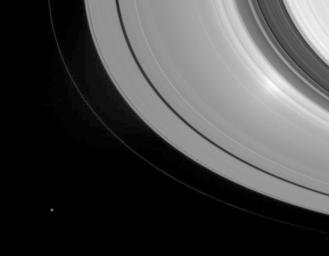When Cassini gazes down at Saturn's rings with the Sun directly behind the spacecraft, an unusual phenomenon called the "opposition effect" can be seen. The effect is visible here as a bright region, near right, toward the inner edge of the A ring.
The precise nature of the effect at Saturn is still under scrutiny by imaging scientists. However the effect in Saturn's rings can be witnessed from Earth, when the viewing conditions are right. It can also be seen in photographs of the lunar surface taken by the Apollo astronauts.
To understand the effect, imagine an observer standing on a dry, sandy beach. When the Sun is directly behind the observer, the shadows cast by the grains in the field of view in front of the observer will fall directly behind the grains and will not be visible. When the Sun is at any other angle relative to the observer, the shadows cast by the grains will be visible to the observer. These shadows in the field of view make the scene a bit darker. This effect would cause a centrally bright spot to appear on the sandy surface in the first case, but not in the second.
For Cassini, the opposition effect is seen when the angle between the Sun, the rings and the spacecraft is extremely close to zero. For the sequence of images during which this view was obtained, Cassini maintained this viewing angle and the bright spot appeared to move across the rings with the spacecraft's motion.
The moon Janus (181 kilometers, or 113 miles, across) is seen here at lower left.
The image was taken in visible light with the Cassini spacecraft wide-angle camera on June 7, 2005, at a distance of approximately 738,000 kilometers (458,000 miles) from Saturn. The image scale is 40 kilometers (25 miles) per pixel.
The Cassini-Huygens mission is a cooperative project of NASA, the European Space Agency and the Italian Space Agency. The Jet Propulsion Laboratory, a division of the California Institute of Technology in Pasadena, manages the mission for NASA's Science Mission Directorate, Washington, D.C. The Cassini orbiter and its two onboard cameras were designed, developed and assembled at JPL. The imaging team is based at the Space Science Institute, Boulder, Colo.
For more information about the Cassini-Huygens mission visit http://saturn.jpl.nasa.gov. For additional images visit the Cassini imaging team homepage http://ciclops.org.

 Planetary Data System
Planetary Data System












